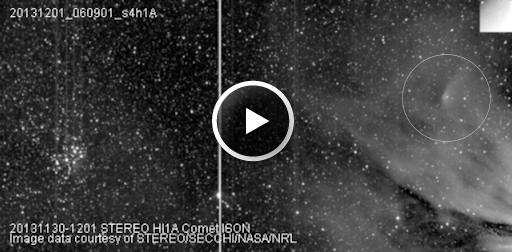M-CLASS FLARE: Solar activity ticked upward slightly on Dec. 7th at 07:29 UT with an M1-class solar flare from sunspot AR1909. NASA's STEREO probes detected a CME emerging from the blast site, near the sun's southwestern limb. Earth could receive a glancing blow from the CME on Dec. 9-10. The flare also produced strong VHF radio emissions and a wave of ionization in the over Europe: data. Solar flare alerts: text, voice
THE GHOST OF COMET ISON: This morning, Dec. 6th, leading researchers from the Comet ISON Observing Campaign (CIOC) held an informal workshop at the Johns Hopkins Applied Physics Lab. One of the key questions they discussed was, Did Comet ISON survive? It might seem surprising that anyone is still asking. After all, the "comet" that emerged from the sun's atmosphere on Thanksgiving day appeared to be little more than a disintegrating cloud of dust. This movie from the STEREO-A spacecraft (processed by Alan Watson) shows the V-shaped cloud fading into invisibility on Dec. 1st:
The answer hinges on the contents of that cloud. Is it nothing more than a cloud of dust--or could there be some some fragments of the disintegrated nucleus still intact and potentially active?
A key result announced at the workshop comes from SOHO, the Solar and Heliospheric Observatory. According to the spacecraft's SWAN instrument, the comet stopped producing so-called Lyman alpha photons soon after its closest approach to the sun. Karl Battams of the CIOC explains what this means: "Without getting technical, Lyman-Alpha is a consequence of sunlight interacting with hydrogen, and if we are not seeing that interaction then it means that the levels of hydrogen (and hence ice) are extremely low. This is indicative of a completely burned out nucleus, or no nucleus at all."
"The evidence appears strong that at some point approaching perihelion - whether days or hours - Comet ISON likely began to completely fall apart," he continues. "What remains of ISON now is going to be either just a cloud of dust, or perhaps a few very depleted chunks of nucleus. Either way, it's not going to flare up at this point and we should assume the comet's show is over."
"However, we do need to verify this," says Battams. "Hopefully the Hubble team can come to the rescue! In mid-December, Hubble will be pointed in the direction of where ISON should be and they'll try and image something. If no fragments are surviving, or they are tiny, then Hubble will not be able to find anything, but that negative detection will tell us something: namely that ISON is indeed gone for good."
Stay tuned!

Solar wind
speed: 345.2 km/sec
density: 5.8 protons/cm3
explanation | more data
Updated: Today at 1616 UT
X-ray Solar Flares
6-hr max: C1 1001 UT Dec07
24-hr: M1 0730 UT Dec07
explanation | more data
Updated: Today at: 1600 UT
![]()
Daily Sun: 07 Dec 13
Sunspot AR1909 poses a threat for M-class solar flares. Credit: SDO/HMI
![]()
Sunspot number: 105
What is the sunspot number?
Updated 07 Dec 2013
Spotless Days
Current Stretch: 0 days
2013 total: 0 days (0%)
2012 total: 0 days (0%)
2011 total: 2 days (<1%)
2010 total: 51 days (14%)
2009 total: 260 days (71%)
Since 2004: 821 days
Typical Solar Min: 486 days
Update 07 Dec 2013
The Radio Sun
10.7 cm flux: 151 sfu
explanation | more data
Updated 07 Dec 2013
![]()
Current Auroral Oval:
Switch to: Europe, USA, New Zealand, Antarctica
Credit: NOAA/POES
![]()
Planetary K-index
Now: Kp= 1 quiet
24-hr max: Kp= 2 quiet
explanation | more data
Interplanetary Mag. Field
Btotal: 2.9 nT
Bz: 0.4 nT south
explanation | more data
Updated: Today at 1607 UT
![]()
Coronal Holes: 07 Dec 13
A stream of solar wind flowing from the indicated coronal hole should reach Earth on Dec. 8-9. Credit: SDO/AIA.





